Many landscapes have a spot where the sun beats down nearly all day. Couple that with the reflected heat that often accompanies that sunlight, and it is easy to understand why traditional container plants like flowering annuals struggle to survive. This is especially true for landscapes in arid climates.
Instead of fighting to keep flowering annuals and perennials alive, or settling for a bare garden area, why not create a container garden of succulents? Succulents, including cactuses, will embrace the sun and heat while adding beauty to your outdoor space with minimal water and fuss.
Let’s look at what you need to create an attractive succulent container garden in an area with full sun and heat.
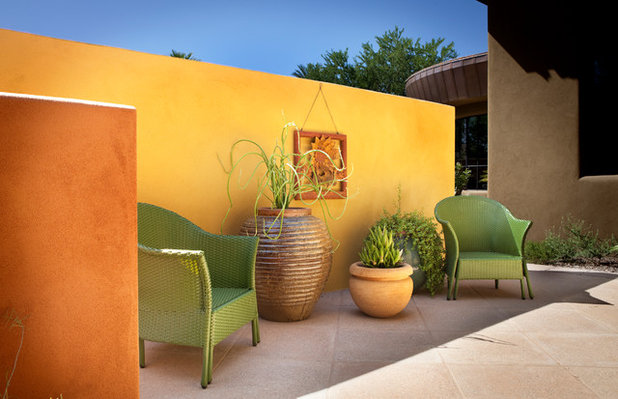
Bianchi Design
1. Study the LocationDeciding where to locate your sun- and heat-loving container garden starts with what direction the proposed area faces. Northern exposures are generally too shady, while areas that face west should be reserved for the toughest of succulents, including cactuses that can handle the tough reflected heat. South-facing exposures are ideal.
Try to choose a spot that receives full sun for most of the day. Your sun-worshipping plants should be fine if your chosen area gets light shade for a couple of hours each day, and they might welcome a little relief from the sun’s intense rays.
Here, containers filled with slipper plant (
Pedilanthus macrocarpus)
and trailing
elephant bush
(
Portulacaria afra) create interest in front of a colorful wall.
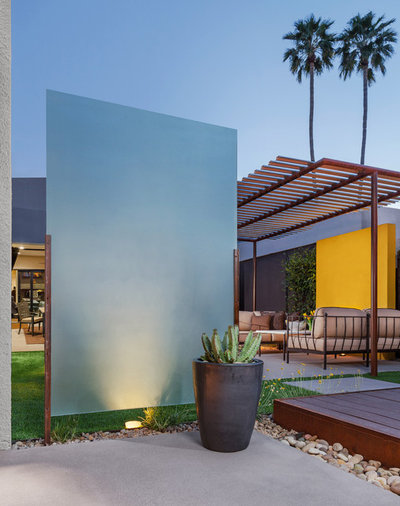
Coffman Studio
2. Get the Container RightWhether you choose a brightly colored pot or one with an unusual texture or shape, make sure it has holes for drainage. Clay, glazed and plastic containers are all suitable for growing succulents. The ceramic container seen here holds resin spurge (
Euphorbia resinifera).
Contrary to most container gardening suggestions, avoid an oversized container, as the soil will take longer to dry out, increasing the chances that the roots will rot. A good guideline is to have about 2 to 4 inches between the succulent and the edge of the container. For columnar cactuses, the space between the cactus and the edge of the pot should be half the length of the cactus.
It’s important to note that, like many container plants, succulents can outgrow their pots, at which time they can be repotted into larger containers or planted in a sunny spot in the garden.
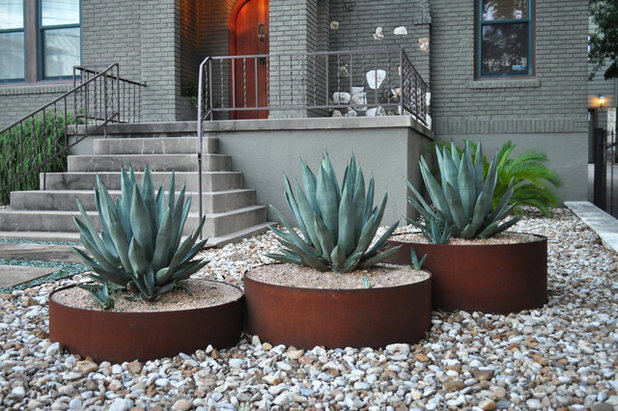
ADLA Studio
A trio of agave grows in custom rusted metal containers.3. Use the Right SoilWhile cactuses and other succulents are fairly low-maintenance, they all must have extremely well-drained soil or they will rot. Commercial mixes formulated for cactuses and succulents aren’t always the best choice for your pots. They can stay moist for too long, and water has a hard time penetrating the soil after it has dried out to due the high amounts of peat it contains.
The best soil mix for your succulents is one you create yourself. There are a variety of formulas, but a good basic succulent soil can be made by mixing equal parts sand, potting soil and perlite.
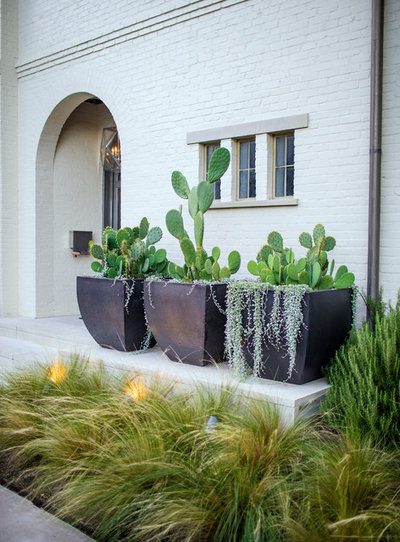
AquaTerra Outdoors
4. Pick Your PlantsCheck each succulent’s exposure requirement, making sure it is suitable for full sun. This information can be found on the plant label, or you can ask your local nursery professional.
Cactuses, like this prickly pear (
Opuntia sp.), relish the sun’s rays, perhaps more than any other type of succulent. They add a distinct element to garden spaces with their unusual fleshy stems shaped like globes, paddles and tall columns. Because most cactuses have thorns, take care to locate them in areas where passersby won’t get accidentally pricked.
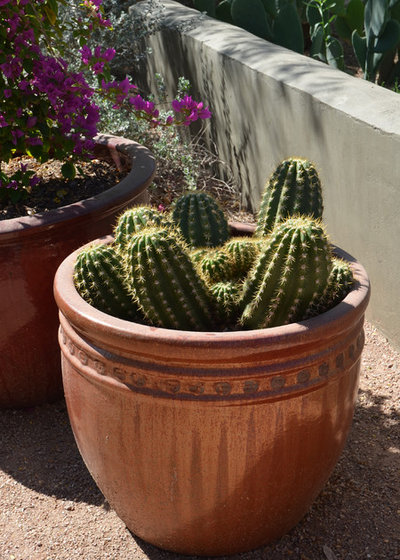
Noelle Johnson Landscape Consulting
Torch cactus (a
Trichocereus hybrid) waits until summer to produce large, colorful flowers.
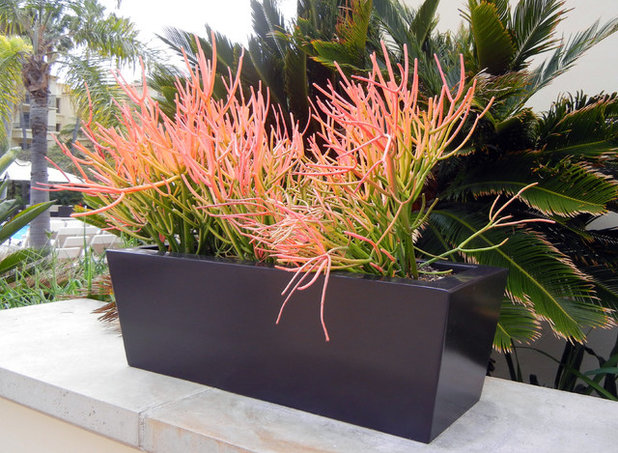
Creative Design by Lauran LLC
Euphorbia is a large genus of plants, many of which are sun-loving succulents that come in a variety of colors and shapes. Some are tall, columnar succulents, while others are low-growing ground covers; some euphorbias have spines and others do not. The brilliant orange stems of ‘Sticks on Fire’ milk bush (
Euphorbia tirucalli ‘Sticks on Fire’) shine in this modern container.
All euphorbias have a milky sap that can be irritating or even poisonous, so use them with care around children and pets, and be sure to wear gloves when pruning.
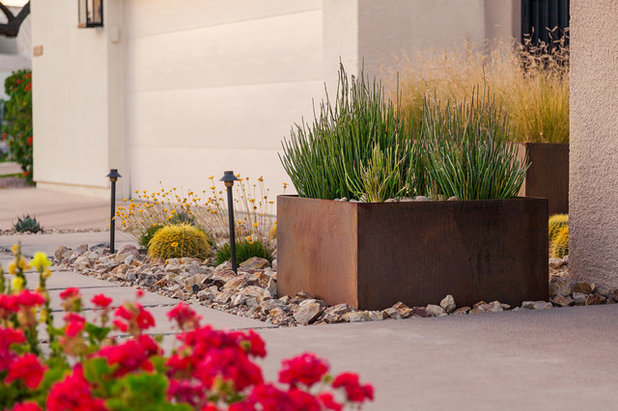
Coffman Studio
Candelilla, a species of euphorbia, is planted in a rusted metal raised bed, and is thriving in full sun and reflected heat.See how to grow euphorbias
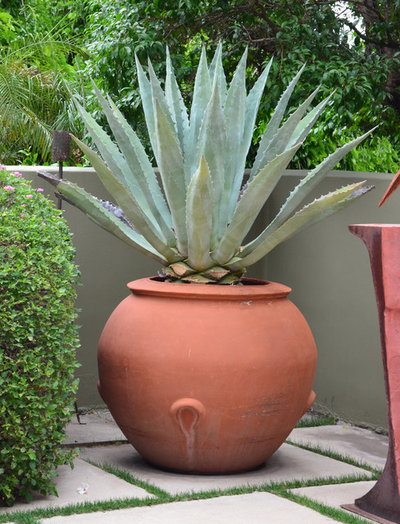
Noelle Johnson Landscape Consulting
Agaves,
with their attractive spiky rosette shapes, add drama to hot, sunny corners. Several species are suitable for full-sun exposures, including Parry’s agave (
Agave parryi) and
Agave ocahui as well as the large American century plant (
Agave americana),
shown here, and the petite Queen Victoria agave (
Agave victoriae-reginae ‘Compacta’).
The sharp tips of agave can be snipped off with a pair of hand pruners to help avoid getting inadvertently stabbed.
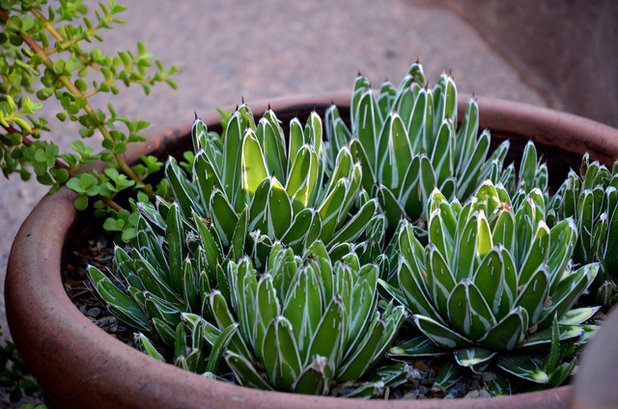
Noelle Johnson Landscape Consulting
‘Compacta’ Queen Victoria agave plants fill a wide and shallow container.
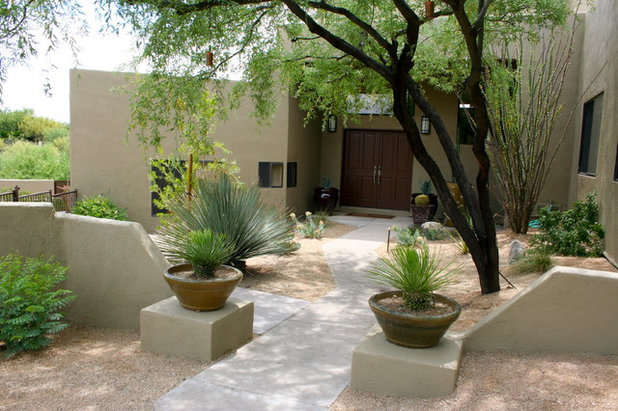
Prideaux Design
Potted twin flower agaves (
Agave geminiflora)
flank an entry here. This agave species is noted for its finely textured leaves and ability to thrive in full sun as well as in shady locations.
Decorate the Landscape With Versatile Agave
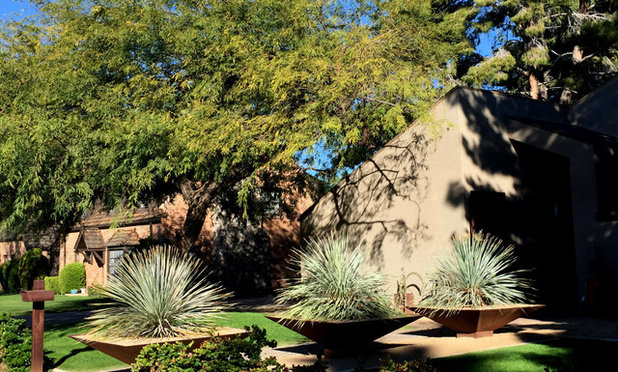
Noelle Johnson Landscape Consulting
A trio of Dasylirion wheeleri adds a contemporary look to this Phoenix front yard.In addition to agave, cactuses and euphorbias, succulents like ‘Blue Elf’ aloe (
Aloe ‘Blue Elf’), common sotol (
Dasylirion wheeleri), elephant bush (
Portulacaria afra), Mexican fence post (
Pachycereus marginatus) and slipper plant (
Pedilanthus macrocarpus) flourish in containers in hot, full sun.
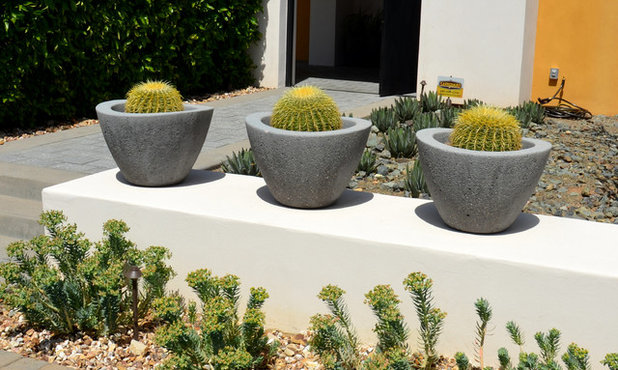
Noelle Johnson Landscape Consulting
5. Plant and Care for Your ContainersPlanting. Planting succulents with thorns, especially cactuses, should be approached with caution. There are several ways, using everyday items from around the home, to avoid getting stabbed.
Gardening gloves are the first line of defense, but they aren’t enough to provide full protection. For smaller, globe-shaped cactuses such as golden barrel cactus (
Echinocactus grusonii), shown here, an old towel that has been folded into four layers can be used to handle the cactus while planting. Tall columnar cacti, like Mexican fence post
(
Pacycereus marginatus) as well as prickly pear (
Opuntia spp.) can be handled using small sections of carpet or several layers of newspaper. A good pair of tongs can also be helpful for planting small cactuses.
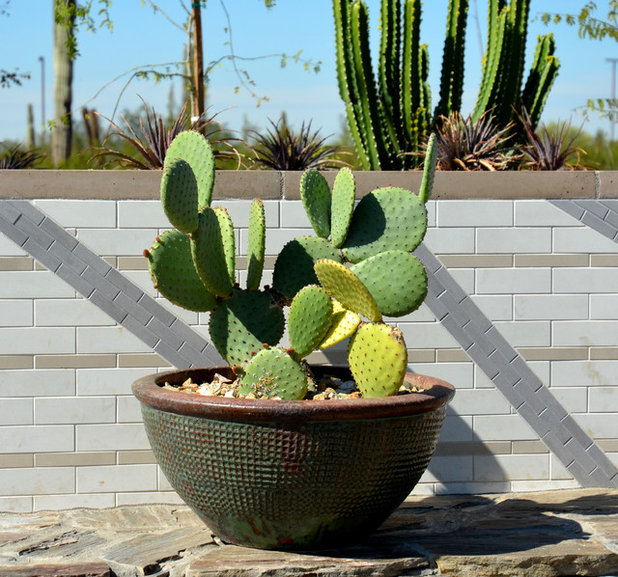
Noelle Johnson Landscape Consulting
Succulents of the same species can be planted singly or in groups of three, creating a simple yet dramatic statement. A prickly pear cactus (
Opuntia sp.) provides a simple yet elegant design element in this sunny spot that receives hot reflected heat.
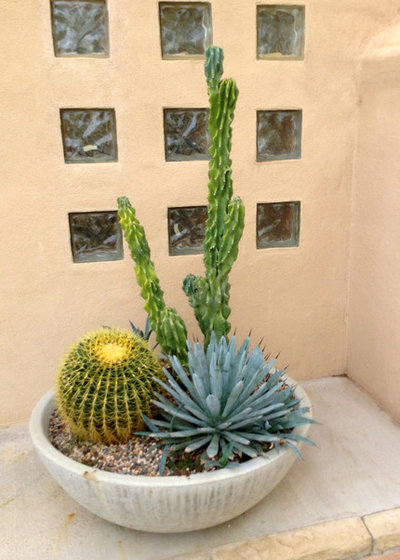
Noelle Johnson Landscape Consulting
Alternatively, you can group several types of succulents, creating pleasing color and texture contrasts. In this photo,
Pachycereus schottii var. monstrosus adds height behind the globular golden barrel cactus and the spiky rosette of
Agave macroacantha. When selecting a mix of plants, make sure that they have the same water requirements.
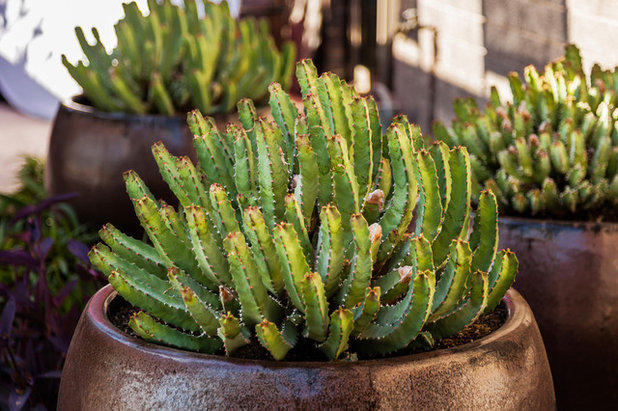
Coffman Studio
Resin spurge (Euphorbia resinifera) fills containers that mimic their curved shape.Fertilizing. When grown in containers, succulents need a monthly application during the growing season, in spring and summer, of a low-nitrogen fertilizer. Fish emulsion can also be used as a fertilizer. Whichever fertilizer you choose, it’s important to use it at only half the recommended strength.
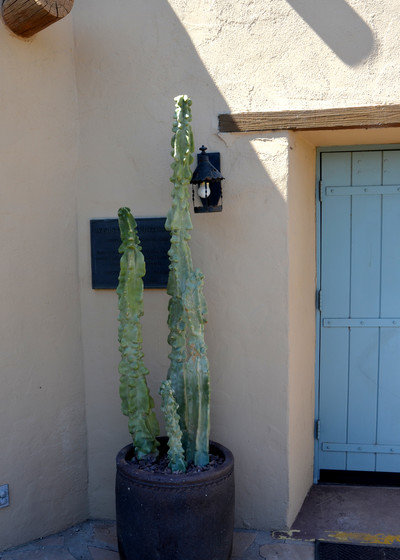
Noelle Johnson Landscape Consulting
Thornless totem pole cactus (Pachycereus schottii var. monstrosus) has an unusual melted-candle appearance.
Watering. The frequency of watering depends on several variables, including the season, temperature, humidity, exposure and container size. The soil should be almost completely dry before you water. An easy way to determine when it’s time to water is by sticking your finger all the way into the soil. The soil should be barely moist, almost dry, before you water it again. Water until it runs out the bottom through the drainage hole.
When in doubt, water less, not more. Succulents are often killed by overwatering. Watch for wrinkling or shriveling in spring or summer, which is a sign that the cactus needs more water.
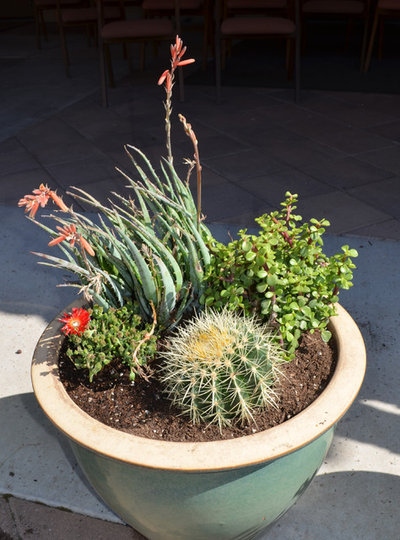
Noelle Johnson Landscape Consulting
This pot contains ‘Blue Elf’ aloe, golden barrel cactus, royal dewflower (Drosanthemum speciosum) and elephant bush.It is a myth that cactuses need no water. Cactuses, like other succulents, store water inside their leaves or stems. Spring and summer are the main growing seasons, when water should be applied. With the arrival of fall, the frequency of watering should be slowly reduced. Watering in winter is usually not needed unless rainfall is absent.





